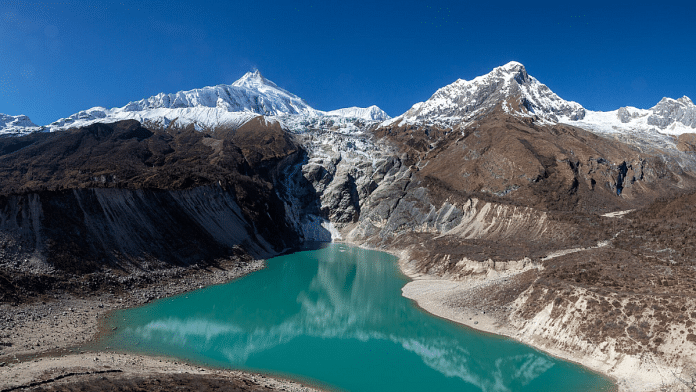Bengaluru: Yet another Glacial Lake Outburst Flood (GLOF) event has occurred in the Himalayas. This time, the Birendra glacial lake in Nepal collapsed and caused a brief deluge downstream.
As temperatures rise, glaciologists have been raising alarms over increasing GLOF events. Just last October, the South Lhonak glacial lake in Sikkim suffered an outburst due to a cloudburst, leading to major loss of lives.
The Birendra Tal, which is located at 4500 m above sea level in the Manaslu region, burst its banks Sunday morning due to an avalanche dumping ice into it, spilling water over. It is currently reported to be “returning to normal”.
There have been no report of casualties despite downstream regions being on high alert. Satellite images have indicated that bridges and yaks were swept up in the water. The images also show a new chunk of ice and snow at the southwestern part of the lake, indicating an avalanche and deposition of ice into the lake.
Snow/ice is seen floating on the lake in the latest @planet image; lake outflow deposits are seen to have increased just below the outlet and downstream @basanta58_raj @DHM_FloodEWS @NDRRMA_Nepal @DrMiriamJackson pic.twitter.com/6op5JQe0Ut
— Dr. Ashim Sattar (@GlacierHazards) April 21, 2024
Researchers in countries around the Himalayas have been assessing and compiling glacial lake risks for GLOF events, and studies have identified lakes that are at high risk. The Birendra Tal GLOF event yet again stresses on the importance of mitigating risks from such lakes.
ThePrint explains how researchers are working to understand GLOF risks and mitigation measures that could be taken.
How can GLOF risk be mitigated?
Many hazard experts have already conducted experiments with lakes where they have tried to artificially drain the lake and lower its level, to prevent it from spilling water over its brim. Lakes like Gepang Gath have shown that just lowering a lake by 10 metres reduces the risk by 54 percent for today, and 63 percent for future climate scenarios. Further lowering by another 20m leads to a reduction of 78 percent and 93 percent, respectively.
The study’s lead author, glaciologist and debris flow expert Ashim Sattar, currently at IIT Bhubaneswar, told ThePrint that actions need to be taken as soon as possible to mitigate GLOF risk. For this, researchers such as himself work on building detailed hazard assessments of existing glacial lakes.
Also Read: ‘Killer’ cold waves in oceans lead to migration of marine species, finds Nature Climate Change study
How prone is Himalayan region to GLOF events
The Himalayas are the riskiest regions in the world for GLOF events, which threaten almost 90 million people.
The need to perform risk assessments on all lakes is especially high as glaciers start to melt, because the Himalayas contain the most ice after the Arctic and the Antarctic. In fact, the mountain ranges are often referred to as the Third Pole, and melting glaciers are at a risk of discharging high quantities of water downstream, affecting India, Pakistan, Nepal, Tibet, China, and Bhutan.
The risk is also amplified by water from melting glaciers starting to pool in some regions, leading to the formation of new glacial lakes. This natural reservoir of water also holds all the soil and rock that is washed down by the water as well as pushed by glaciers creeping forward. This accumulation of debris is called a moraine, and usually contains the lake in. Increasing avalanches also contribute to risk.
Future measures to be taken immediately
Nepal has taken active measures to reduce GLOF risk. Following two major outburst floods in the 1980s, it began to implement a series of active measures for safety, starting in 1999, when the first glacial lake was artificially drained near Mt. Everest.
While artificially lowering the level of lakes can work in some cases, it is difficult to implement this across the Himalayas owing to the unique structure of each lake and the difficult terrain.
“In the Himalayas, glacial lakes are located at high altitudes and freezing temperatures,” said Sattar. “The subzero temperature will allow water to freeze within the siphons and sometimes might not be effective during winters.”
Indian scientists are actively working on mitigation measures, making use of satellite images, retrofitting unsafe constructions, and developing new models to identify GLOF risk.
Early warning systems play a key role in minimising damage and casualties, but are lacking conspicuously in regions of high risk. Sattar explained that implementation of GLOF regulations are also necessary, such that future building of infrastructure and settlements depend on the potential risk posed by upstream lakes.
(Edited by Tony Rai)



